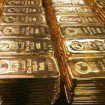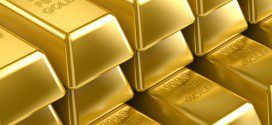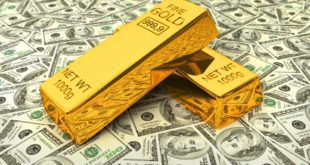…Many gold bugs hold out hope…that any day now, gold will resume its march upward to $2,000, then $5,000 and then $10,000 per ounce…In answer to the question “How can anyone reasonably calculate what the value of gold is?” I want to put forth in this post a possible model for…[doing just that]. The purpose of the model isn’t to say where gold will go but to look at the underlying factors that drive the price of the precious metal.
upward to $2,000, then $5,000 and then $10,000 per ounce…In answer to the question “How can anyone reasonably calculate what the value of gold is?” I want to put forth in this post a possible model for…[doing just that]. The purpose of the model isn’t to say where gold will go but to look at the underlying factors that drive the price of the precious metal.
The above introductory comments are edited excerpts from an article* by Eddy Elfenbein, (crossingwallstreet.com) entitled A Deep Dive into a Model That Helps Explain Gold Prices.
The following article is presented courtesy of Lorimer Wilson, editor of www.munKNEE.com (Your Key to Making Money!), and www.FinancialArticleSummariesToday.com (A site for sore eyes and inquisitive minds) and has been edited, abridged and/or reformatted (some sub-titles and bold/italics emphases) for the sake of clarity and brevity to ensure a fast and easy read. This paragraph must be included in any article re-posting to avoid copyright infringement.
Elfenbein goes on to say in further edited excerpts:
…The key to understanding the gold market is understanding that it’s not really about gold at all. Instead, it’s about currencies, and in our case that means the U.S. dollar. Properly understood, gold is really the anti-currency. It serves a valuable purpose in that it keeps all the other currencies honest—or exposes their dishonesty.
This may sound odd, but every major currency has an interest rate tied to it. It doesn’t matter if it’s the euro, the pound or the yen. In essence, that interest rate is what the currency is all about.
Before I get to my model, we need to take a slight detour and discuss a fascinating paradox known as Gibson’s Paradox. This is one the most puzzling topics in economics. Gibson’s Paradox is the observation that interest rates tend to follow the general price level and not the rate of inflation. That’s very strange, because it seems obvious that as inflation rises, interest rates ought to keep up. Similarly, as inflation falls back, rates should move back as well but, historically, that hasn’t been the case. Instead, interest rates have risen as prices have gone up, and only fallen when there’s been deflation.
This paradox has totally baffled economists for years yet it really does exist. John Maynard Keynes called it “one of the most completely established empirical facts in the whole field of quantitative economics.” Milton Friedman and Anna Schwartz said that “the Gibsonian Paradox remains an empirical phenomenon without a theoretical explanation.”
Even many of today’s prominent economists have tried to tackle Gibson’s Paradox. In 1977, Robert Shiller and Jeremy Siegel wrote a paper on the topic. In 1988 Robert Barsky and none other than Larry Summers took on the paradox in their paper “Gibson’s Paradox and the Gold Standard.” It’s this paper that I want to focus on. (By the way, in this paper the authors thank future econo-bloggers Greg Mankiw and Brad DeLong.)
Summers and Barsky agree that the Gibson Paradox does indeed exist. They also say that it’s not connected with nominal interest rates but with real (meaning after-inflation) interest rates. The catch is that the paradox only works under a gold standard. Absent that standard, the Gibson Paradox fades away.
Now here’s my big idea: the Gibson Paradox doesn’t go away. It’s still here, just harder to see. It’s my hypothesis that Summers and Barsky were on to something, and that we can use their insight to build a model for the price of gold. The key is that gold is tied to real interest rates. Where I differ from them is that I use real short-term interest rates, whereas they focused on long-term rates.
We’re getting closer to our model, but we need to take yet another detour, this time to Sweden to discuss the great Swedish economist Knut Wicksell. Wicksell was an interesting character who wrote on many topics, but he was deeply concerned with the theory of interest rates.
Now Wicksell was an economist, and consequently he wasn’t always the clearest writer. He often seemed to get his interest rates confused. One economist referred to this as the “Wicksellian muddle.” What’s important, though, is that Wicksell believed there was a constant tug-of-war between two interest rates. One is the interest you see in the real world, the money rate. The other is an invisible phantom rate called the natural rate. While unseen, this natural rate does make its presence known in various ways. Wicksell believed that when the money rate drops below the natural rate, the economy grows and prices rise. When the opposite happens, the economy contracts and prices fall.
I believe that if we take the Wicksellian natural rate and view it through the prism of a still-functioning Gibson’s Paradox, we can understand how gold’s value works.
Here’s what Wicksell wrote (page 102):
“There is a certain rate of interest on loans which is neutral in respect to commodity prices, and tend neither to raise nor to lower them. This is necessarily the same as the rate of interest which would be determined by supply and demand if no use were made of money and all lending were effected in the form of real capital goods. It comes to much the same thing to describe it as the current value of the natural rate of interest on capital.”
Bingo! It’s that natural rate that’s the key to our model. In the first iteration of my model, I used 2%.
That was wrong, but I was fooled because. [While] 2% works well enough as a long-term approximation of the Wicksellian natural rate, the natural rate is not a constant.
Here’s how it works.
- Whenever the dollar’s real short-term interest rate is below the Wicksellian natural rate, gold rallies.
- Whenever the real short-term rate is above the natural rate, then gold falls. Just as the Knut Man describes.
- When gold holds perfectly still, you know you’re at the natural rate.
- It’s my contention that this was what the Gibson Paradox was all about, since the price of gold is tied to the general price level.
Now we get to the messy parts. There’s a lot of volatility in this relationship. According to my original model:
- For every one percentage point real rates differ from the natural rate, gold moves by eight times that amount per year. So if the real rates are at 1% and the natural rate is at 2%, gold will move up at an 8% annualized rate.
- If real rates are 2% below the natural rate, then gold will move up at a 16% rate (that was about the story from 1999 to 2011).
- Conversely, if the real rate jumps to 1% above the natural rate, then gold will drop at an 8% rate.
Why eight fold? There, I don’t know. When I did the back test, that number fit the best. I assume it’s a risk factor to compensate for owning gold.
Here’s the graph from my original model, bearing in mind that I used 2% as the natural rates.
I realize I have a problem with using an unspecified Wicksellian natural interest rate, since I’m using one variable to explain another variable. That’s not quite kosher in the model-building biz. Perhaps I could use the price of gold and current interest rates to reverse-engineer the Wicksellian natural rate. Gold has been falling for the last three years, even though real short-term rates have been quite low. In fact, negative. The natural rate may have fallen as well.
Let me make it clear that this is just a model, and I’m not trying to explain 100% of gold’s movement.
- Gold is subject to a high degree of volatility and speculation.
- Geopolitical events, for example, can impact the price of gold.
- I would also imagine that at some point, gold could break a replacement price where it became so expensive that another commodity would replace its function in industry, and the price would suffer.
Instead of explaining every aspect of gold’s behavior, my aim is to pinpoint the underlying factors that are strongly correlated with it. There are a few key takeaways.
- gold is not tied to inflation – it’s tied to low real rates, which are often the by-product of inflation. Rising gold and low inflation isn’t a contradiction. We had both for a few years.
- When real rates are low, the price of gold can rise very, very rapidly.
- When real rates are high, gold can fall very, very quickly.
- There’s no reason for there to be a relationship between equity prices and gold (like the Dow-to-gold ratio).
- The price of gold is essentially political. If a central banker has the will to raise real rates as Volcker did 35 years ago, then the price of gold can be crushed.
Editor’s Note: The author’s views and conclusions in the above article are unaltered and no personal comments have been included to maintain the integrity of the original post. Furthermore, the views, conclusions and any recommendations offered in this article are not to be construed as an endorsement of such by the editor.
*http://www.crossingwallstreet.com/archives/2014/07/the-gold-model-revisited.html (© Copyright 2014 Crossing Wall Street. You can sign up for my free newsletter here.)
Follow the munKNEE!
- Register for our Newsletter (sample here)
- Find us on Facebook
- Follow us on Twitter (#munknee)
- Subscribe via RSS
Related Articles:
1. The Future Price of Gold and the 2% Factor
It is my contention that the price of gold rallies whenever the U.S. dollar’s real short-term interest rate is below 2%, falls whenever the real short rate is above 2%, and holds steady at the equilibrium rate of 2%. Let me explain. Read More »
2. Gibson’s Paradox and the Price of Gold
One of the most controversial topics in investing is the price of gold… [with] many goldbugs say[ing]…that gold will soon break $2,000, then $5,000 and then $10,000 an ounce but, [frankly,] how can anyone reasonably calculate what the price of gold [should be when they don’t understand the factors that drive gold? So let me explain.] Words: 992 Read More »
3. Low Real Interest Rates Say Gold Bull Still Has Legs! Here’s Why
Many agree that the United States’ massive budget deficits and global monetary inflation support the gold bull market. I don’t see this changing in the near future. Still, sentiment is not enough upon which to rely. I need a yardstick and, for me, that yardstick is U.S. real interest rates. [Let me explain why that is the case.] Words: 1600 Read More »
 munKNEE.com Your Key to Making Money
munKNEE.com Your Key to Making Money



